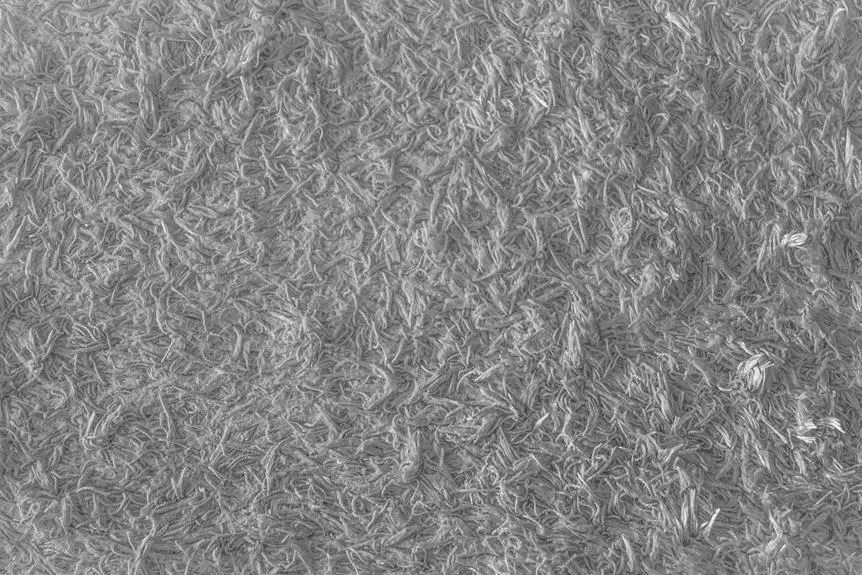You might be wondering if microfleece is a practical option for swimwear cover-ups. Given its lightweight and breathable nature, it seems like a viable choice for those cooler beach days. However, there could be drawbacks, especially when it comes to heat retention and water absorption. Exploring the benefits and limitations will help you make the best decision for your swimwear wardrobe. But what are the alternatives, and can they truly match the comfort and style of microfleece?
Table of Contents
What Is Microfleece?
Microfleece is a lightweight, synthetic fabric made from polyester that offers exceptional warmth and softness, making it a popular choice for casual clothing and outdoor gear. You might appreciate its soft texture, which feels gentle against your skin, ensuring comfort throughout the day.
Unlike heavier fabrics, microfleece is breathable, providing good moisture-wicking properties. This means it helps keep you dry by drawing sweat away from your body, which can be especially beneficial if you're active outdoors or enjoying a day at the beach.
The fabric's construction consists of fine fibers that create a pile, giving it that plush feel you enjoy. Microfleece is well-known for its insulative properties; it traps heat without adding bulk, which can be perfect for layering on cooler days.
Additionally, it dries quickly, so you won't have to wait long before putting it back on after washing or when it gets wet.
As you explore options for your wardrobe, remember that microfleece is versatile. It works well for jackets, pullovers, and even activewear, allowing you to stay comfortable whether you're lounging at home or adventuring outside.
You'll find that it's a fantastic fabric for various situations, making it a great addition to your collection.
Benefits of Microfleece for Cover-Ups
When you're looking for cover-ups, microfleece offers a unique blend of softness and comfort that feels great against your skin.
Plus, its quick-drying properties ensure you stay dry and cozy after a swim.
You'll love how practical and stylish microfleece can be for your beach days.
Softness and Comfort
There's no denying that the softness of microfleece makes it a delight to wear as a swimwear cover-up. The gentle texture feels great against your skin, ensuring comfort whether you're lounging by the pool or strolling along the beach. This softness is a significant factor in enhancing your overall experience in swimwear cover-ups.
1. Lightweight Feel: Microfleece is breathable and lightweight, so you won't feel weighed down. You can move freely, whether you're slipping it on after a swim or enjoying a beach bonfire.
2. Warmth Without Bulk: Unlike other fabrics that can be bulky or heavy, microfleece provides cozy warmth without feeling cumbersome. It's perfect for those cooler days when you still want to enjoy the outdoors.
3. Low Friction: The smooth surface of microfleece reduces friction, preventing chafing and irritation. You can wear it all day without discomfort, allowing you to fully relax and enjoy your time in the sun.
With these advantages, microfleece cover-ups truly offer the softness and comfort you crave.
Quick-Drying Properties
One of the standout benefits of using microfleece for swimwear cover-ups is its impressive quick-drying properties, making it perfect for those spontaneous dips in the water. When you're lounging by the pool or hitting the beach, the last thing you want is to stay wet after a swim.
Microfleece rapidly wicks moisture away from your skin, so you can throw on your cover-up and dry off in no time. This material doesn't just dry fast; it also helps regulate your body temperature. After swimming, you'll appreciate how microfleece keeps you warm without being bulky. It's also lightweight, which means you can easily pack it in your beach bag without taking up too much space.
Another perk is that microfleece resists water absorption, so you won't find yourself drenched while waiting for your next swim. Enjoy the convenience of a cover-up that transitions with you, from wet to dry, effortlessly.
Plus, with less drying time, you're ready to socialize or sunbathe sooner. Overall, microfleece cover-ups combine practicality and style, making them an excellent choice for any beach or pool day.
Drawbacks of Using Microfleece
While microfleece has its benefits, you should be aware of some drawbacks before choosing it for swimwear cover-ups. It tends to retain water, making you feel heavier and colder when wet.
Additionally, the material can trap heat and limit breathability, which mightn't be ideal for hot days by the pool.
Retention of Water
Microfleece tends to retain water, which can leave you feeling damp and uncomfortable after a swim. While it's soft and cozy, you might find that its moisture-wicking properties aren't as effective as you'd like.
Prolonged Dampness: Since microfleece absorbs water, you won't dry off quickly after taking a dip. This prolonged dampness can lead to a chilling effect, especially if you're outside in cooler conditions.
Increased Weight: Wet microfleece can feel heavy against your skin. When soaked, the fabric's weight could become burdensome, making it less pleasant to wear as a cover-up while you lounge by the pool or beach.
Odor Potential: If microfleece stays wet for too long, it might develop a musty smell. This can be bothersome if you plan to wear it regularly after swimming, making your leisure time less enjoyable.
Choosing the right fabric for your swimwear cover-up helps ensure your post-swim experience remains comfortable and refreshing. Consider alternatives that dry faster and manage moisture better!
Heat Retention Issues
The fabric's heat retention can leave you feeling too warm and stuffy, especially on sunny days after swimming. Microfleece is designed to trap warmth, making it an undesirable choice for quick cover-ups when you just want to cool off. If you're transitioning from the cool water to the hot sun, wearing microfleece can intensify discomfort.
You might wonder how it compares to other materials. Here's a quick breakdown:
| Material | Heat Retention | Ideal Conditions |
|---|---|---|
| Microfleece | High | Chilly or windy days |
| Cotton | Moderate | Warm but breezy days |
| Linen | Low | Hot and sunny days |
As this table shows, while microfleece excels in warmth retention, it can hinder your comfort on balmy days. So, if you're planning to lounge on the beach or by the pool after your swim, consider a lighter fabric. Choosing the right material can enhance your experience, allowing you to enjoy the sun while keeping cool.
Limited Breathability Factor
Limited breathability in microfleece can make you feel stifled when you're trying to relax after a swim. While the material offers softness and warmth, it doesn't allow for much air circulation. This can lead to discomfort—especially on warmer days—because moisture from your skin has nowhere to escape.
- Sweat Accumulation: With limited airflow, sweat can build up against your skin, causing that clammy feeling you want to avoid while lounging by the pool.
- Overheating: If you're under the sun, microfleece can trap heat, making you feel hotter than you'd in a more breathable fabric. This is especially frustrating when you seek a cool-down after a swim.
- Skin Irritation: Prolonged wear can lead to irritation or rashes due to the lack of ventilation. This can be a real buzzkill when all you want is to enjoy your time by the water.
Styling Tips for Microfleece Cover-Ups
When styling your microfleece cover-up, think about layering it over your swimsuit to effortlessly elevate your beach look. Choose a cover-up that complements your swimwear, whether you prefer bold patterns or solid colors. If you've got a vibrant swimsuit, a solid microfleece in a neutral shade can balance your outfit beautifully.
Don't shy away from accessorizing. A wide-brimmed hat and stylish sunglasses not only enhance your look but also provide added sun protection. Consider tying your cover-up at the waist for a more structured silhouette, giving you an effortlessly chic vibe.
Footwear matters too! Opt for sleek flip-flops or trendy slides that can easily take you from the beach to a casual lunch date. If you're headed for a day out, consider layering a lighter, breathable top underneath your cover-up to add a bit of versatility.
Care and Maintenance Guidelines
Proper care and maintenance of your microfleece cover-up will ensure it remains soft, vibrant, and ready for your next beach day.
To keep your cover-up in top shape, follow these guidelines:
1. Washing: Always use cold water and a gentle detergent when washing your microfleece. Hot water can damage the fibers and lead to pilling, which you want to avoid. Remember to turn it inside out to protect the outer fabric.
2. Drying: Air drying is the best option for microfleece. If you prefer using a dryer, choose a low heat setting to prevent shrinkage and maintain the fabric's softness. Avoid dryer sheets, as they can reduce the fleecy texture.
3. Storage: When you're not using your cover-up, store it in a cool, dry place. Avoid hanging it for long periods, as this can stretch the fabric. Instead, fold it neatly to preserve its shape and prevent wrinkles.
Alternatives to Microfleece
If you're considering other materials for swimwear cover-ups, there are several alternatives to microfleece that offer both style and function. One great option is cotton terry cloth. It's soft, absorbent, and perfect for drying off after a dip in the pool or ocean. Plus, it comes in a wide range of colors and patterns, so you can easily find one that suits your taste.
Another fantastic choice is lightweight rayon or viscose. These fabrics are breathable and flowy, giving you that effortless vibe you want while staying cool in the sun. They're also easy to pack if you're traveling.
For a sporty look, consider using polyester blends. These materials are quick-drying, making them ideal for cover-ups that will likely encounter water. They offer durability and stretch, ensuring comfort whether you're lounging or taking a stroll.
Finally, think about linen. This fabric's natural breathability and relaxed appearance can give you an effortlessly chic cover-up. It's lightweight and perfect for warm weather.
Each of these alternatives provides unique benefits, allowing you to enjoy your time at the pool or beach while staying stylish and comfortable.
Frequently Asked Questions
Is Microfleece Quick-Drying for Swimwear Cover-Ups?
Microfleece isn't the quickest-drying fabric out there. While it offers some moisture-wicking properties, it takes longer to dry compared to materials specifically designed for swimwear. You might want to consider alternatives for quicker drying.
Can Microfleece Be Used for Sun Protection?
Yes, microfleece can offer some sun protection due to its density, but it isn't a substitute for dedicated swimwear or sunscreen. For optimal sun safety, consider layers specifically designed for UV protection alongside your other garments.
Is Microfleece Eco-Friendly for Swimwear Cover-Ups?
Microfleece isn't typically considered eco-friendly due to its synthetic nature and potential microplastic shedding. You might want to explore alternatives made from natural fibers or recycled materials for a more sustainable swimwear cover-up option.
Does Microfleece Provide Insulation When Wet?
Microfleece doesn't provide much insulation when wet. While it retains some warmth, its ability to wick moisture away decreases significantly. If you're looking for warmth, consider choosing a different material that performs better in wet conditions.
Can Microfleece Be Worn During Beach Activities?
Yes, you can wear microfleece during beach activities. It's lightweight, cozy, and dries relatively quickly, making it a suitable option while you're lounging or walking along the shore. Just ensure you stay comfortable and stylish!
- How Does Ring Spun Cotton Affect Garment Fit and Shape Retention? - August 13, 2024
- What Are the Challenges in Producing Ring Spun Cotton? - August 13, 2024
- Is Ring Spun Cotton Suitable for Plus-Size Clothing? - August 13, 2024







